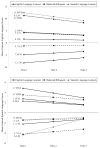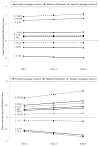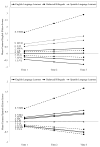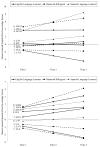Identifying differences in early literacy skills across subgroups of language-minority children: A latent profile analysis
- PMID: 29251963
- PMCID: PMC5886800
- DOI: 10.1037/dev0000477
Identifying differences in early literacy skills across subgroups of language-minority children: A latent profile analysis
Abstract
Despite acknowledgment that language-minority children come from a wide variety of home language backgrounds and have a wide range of proficiency in their first (L1) and second (L2) languages, it is unknown whether differences across language-minority children in relative and absolute levels of proficiency in L1 and L2 predict subsequent development of literacy-related skills. The purpose of this study was to identify subgroups of language-minority children and evaluate whether differences in level and rate of growth of early literacy skills differed across subgroups. Five-hundred and twenty-six children completed measures of Spanish and English language and early literacy skills at the beginning, middle, and end of the preschool year. Latent growth models indicated that children's early literacy skills were increasing over the course of the preschool year. Latent profile analysis indicated that language-minority children could be classified into nine distinct groups, each with unique patterns of absolute and relative levels of proficiency in L1 and L2. Results of three-step mixture models indicated that profiles were closely associated with level of early literacy skills at the beginning of the preschool year. Initial level of early literacy skills was positively associated with growth in code-related skills (i.e., print knowledge, phonological awareness) and inversely associated with growth in language skills. These findings suggest that language-minority children are a diverse group with regard to their L1 and L2 proficiencies and that growth in early literacy skills is most associated with level of proficiency in the same language. (PsycINFO Database Record
(c) 2018 APA, all rights reserved).
Figures





References
-
- Artiles AJ, Rueda R, Salazar JJ, Higareda I. Within-group diversity in minority disproportionate representation: English language learners in urban school districts. Exceptional Children. 2005;71:283–300. https://doi.org/10.1177/001440290507100305. - DOI
-
- Asparouhov T, Muthén B. Auxiliary variables in mixture modeling: Three-step approaches using Mplus. Structural Equation Modeling: A Multidisciplinary Journal. 2014;21:329–341. http://dx.doi.org/10.1080/10705511.2014.915181. - DOI
-
- August D, Shanahan T. Report of the National Literacy Panel on Language-Minority Children and Youth. Mahwah, NJ: Erlbaum; 2006. Executive summary: Developing literacy in second-language learners.
-
- Benjamini Y, Hochberg Y. Controlling the false discovery rate: A practical and powerful approach to multiple testing. Journal of the Royal Statistical Society. 1995;57:289–300. http://www.jstor.org/stable/2346101.
-
- Bialystok E. Reshaping the mind: The benefits of bilingualism. Canadian Journal of Experimental Psychology. 2011;65:229–235. http://dx.doi.org/10.1037/a0025406. - DOI - PMC - PubMed
Publication types
MeSH terms
Grants and funding
LinkOut - more resources
Full Text Sources
Other Literature Sources

